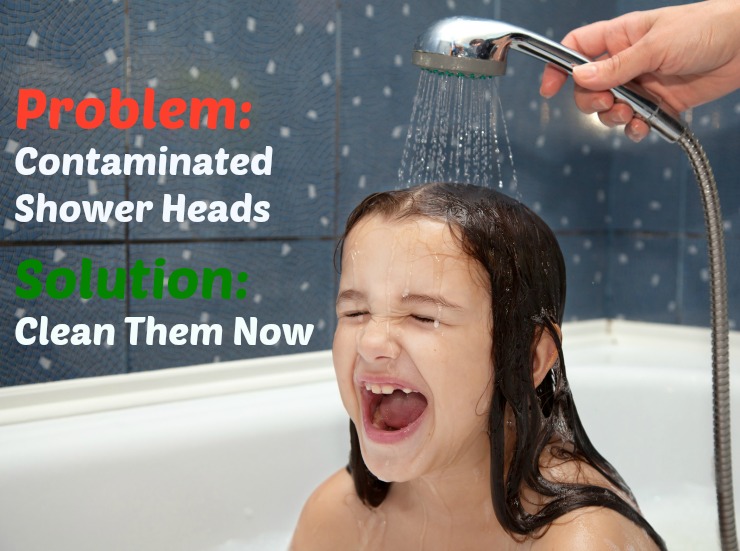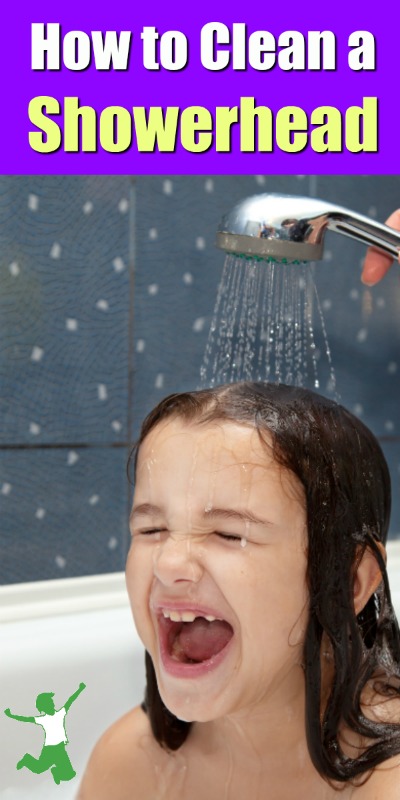One of the dirtiest things in the bathroom is the showerhead, which can get contaminated with an illness causing bacteria that is easily cleaned out with this simple method.
Did you know one of the dirtiest, most disgusting things in your entire home is the innocent looking shower head in your bathroom even if you use a water filter?
This is because shower filters are designed to remove chemicals like chlorine, not necessarily harmful microbes.
In fact, the typical shower head is probably far more contaminated with pathogenic bacteria than the toilet or sink in the same bathroom!
And to think many of us stand under it most days with water cascading over our heads and even straight into our open mouths if we prefer brushing our teeth while showering.
If this is news to you (it was to me!), you are definitely not alone…
Most people have no idea that a showerhead regardless of the model used is a favorite and very common breeding ground for a dangerous microbe that is on the rise.
Researchers call it atypical mycobacteria. But, no need to panic. You can fix the problem today and never worry about it again. Read on!
What is Atypical Mycobacteria?
Atypical mycobacteria are a very common group of microbes that surround us in the natural environment all the time. They are found in the water and soil. However, they can also be found in the air when they become aerosolized into droplets of water small enough to enter the tiny alveoli of the lungs such as what occurs during showering.
Despite being in the same family of bacteria as tuberculosis, atypical mycobacteria do not cause this deadly respiratory disease.
These pathogenic bacterial strains can, however, cause other types of serious health problems particularly when those exposed are already suffering from a weakened immune system or underlying illness. Atypical mycobacteria can cause infections of the skin, lungs, sinuses, lymph nodes, and other parts of the body.
Open wounds are particularly prone to infection from atypical mycobacteria. One species, M. paratuberculosis, is implicated in the development of Crohn’s disease (1).
On the positive side, person to person transmission of an infection with atypical mycobacteria does not occur with the exception of the strains that cause skin lesions. These include M. kansaii and M. simiae (2).
A Shower Head Full of Mycobacteria is a Health Hazard
Normal exposure to atypical mycobacteria in the environment would normally be in very small doses. In these natural situations, risk of infection is very small to nonexistent and would serve to boost immunity rather than cause infection.
However, when a shower head is contaminated with it, exposure can be frequent, intense, and completely overwhelming to the biological systems (3). This is especially true for young children whose immune systems are not yet fully developed.
Showering day after day with these pathogenic microbes pouring all over our skin, into our eyes, nose, and mouth is going to be a problem to our health, the only question is when.
All of us have days when our immune system is depressed for whatever reason. It could be a lack of sleep, an illness which has taken hold temporarily, or stressful family or work situations.
Symptoms of infection with atypical mycobacteria include coughing, breathing problems, and increased mucous production. Fever and overall weakness can present as well. Unexplained weight loss can also occur in extreme situations.
Solve Your Shower Head Issues TODAY
The best thing you can do to prevent atypical mycobacterial infections in yourself and your family is to treat the shower head like anything else in your bathroom: something that needs to be cleaned!
The showerhead cleaning process is simple, and you don’t have to do it that often. Every six months will do just fine!
Here’s what to do:
Shower Head Cleaning Protocol
Every six months, simply fill a sturdy plastic bag with distilled white vinegar (preferably nonGMO white vinegar … conventional is made from GMO corn!) and attach one to every shower head in your home. Large rubber bands can be used to secure the bags tightly.
If it’s easier, remove the showerhead completely and soak it in a bowl of vinegar.
Leave the showerhead soaking in the vinegar for an hour or longer. Do not reuse the bag or the vinegar for other showerheads in your home. In other words, use a fresh bag (or bowl) of vinegar for each shower head that needs to be disinfected.
Finally, remove the bags, dump the vinegar down the sink and run the shower heads to thoroughly flush them out.
Below is a helpful graphic of what to do that you can print out and stick on your refrigerator to remind you if that helps. Another idea is to schedule your twice per year showerhead cleanings at the same time you replace the batteries in your smoke alarms.
Thank you to Mark and Celeste of The Frank Clinic of Chiropractic for sharing this helpful graphic and green living tip that all of us can benefit from!

When I found out this information for the first time, I have to admit that I was more than a little grossed out! I immediately soaked our home’s showerheads as instructed.
Will you be doing the same?









My mom just ordered the Berkey shower head filter for my family. Do you think this is sufficient?
You will still need to clean it.
I think this problem only arises with the shower head. You don’t need to worry about bath faucets.
Sarah, you just help solve me why i have horrible skin condition. My only clue from my doctor was looks like a bacteria infection and give proscribed me clindamycin phosphate Gel UPS, 1% . I use these clues to help find your blog and point me where this monster bacteria is living and my ears to the base of thoat is finally cleared up. *tears* thank you. So ashame I did not clean my showerhead better.
Hi Lindsey, bathroom faucet should be cleaned 1 times a week to avoid a buildup of calcium, can be cleaned with vinegar or CLR (Calcium Lime Rust)
I have a whole house filtration system. Would it be necessary for me to clean the shower head as well? I would think that this system would get rid of most pathogens.